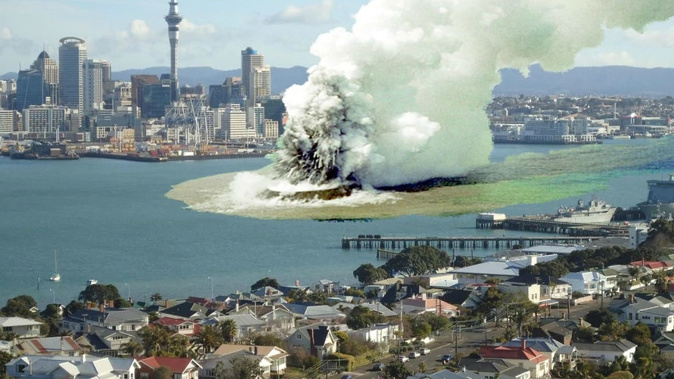
Even a moderate-sized volcanic eruption in Auckland could cost the local economy up to $10 billion - and a push towards intensification could make the city even more vulnerable to disaster.
That's according to researchers who looked at 7270 possible eruption locations to estimate the economic fall-out of a blow in the city.
Much of Auckland is at risk - more than 50 volcanoes lie beneath a field stretching across 360sq km - and more than one million people live on areas where an eruption could occur.
An eruption from one of the volcanoes could blast out an explosion crater 1km to 2km across, destroying everything in it, but planners believe people in its path would be evacuated well before an event.
In their study, the University of Auckland's Professor Shane Cronin and Dr Garry McDonald of consultancy Market Economics modelled a scenario assuming a medium to small sized eruption anywhere in the city.
Such an event could cost between $8b to $9.7b - equivalent to 8.5 per cent to 10.4 per cent of regional GDP.
The study, just published in the Bulletin of Volcanology, follows a 2015 Market Economics paper that found much of Auckland's industrial belt, including Penrose, Onehunga, Otahuhu and East Tamaki, was particularly vulnerable.
But Cronin said all past evaluations had concentrated on physical damage to buildings and roads.
"For this paper we saw the need to look beyond this and into what really happens when communities and businesses are disrupted by disaster - especially in respect of the ability of business to keep operating and to keep people in employment," he said.
"Thus it was really important to look at the dynamic impacts of a volcanic disaster, which can be as big as or greater than the physical damage to property."
They modelled effects by breaking the city down into a series of blocks, before looking at the mix of about 100 business types at each location and in what state they would be more than a year after impact.
Cronin said manufacturing businesses, made inoperable by plants put out of action, or goods and services, cut off from supply chains and transport links, would be badly affected.
But some services businesses could adapt to a disaster through operating from home or a temporary premises.
"Ultimately though, if they are dependent on infrastructure, like roads, they must also stop if there are no mechanisms to re-route."
Cronin expected few businesses in the city would actually be aware of such threats.
"The big change to our economy over the last years is that we are geared to a 'just in time' practice. There are very few businesses that would have any back-up at all.
"Manufacturing businesses and large factories, for example, operate at a critical threshold: they may be able to operate at 80 to 100 per cent, but their systems can't just ramp down to 30 to 40 per cent, depending on demand or supply.
"In addition, they can not easily make up lost ground beyond about 10 per cent excess productivity in post-impact mode - even if workers are available and unaffected - thus losses for some businesses are not easily recovered."
Another of the big implications of the paper was that the push toward intensification in Auckland could make it all the more vulnerable to disaster.
"For example, if all the manufacturing or all of the services is in one location - then disasters could have a massive impact on all of our city and economy," Cronin said.
"While compact city forms are efficient in daily operation, they are not resilient to natural hazards if we look across a spectrum of 100 years of planning.
"Most major cities co-located with various types of hazard and thus this issue of compact versus dispersed city form is being debated throughout the world."
-NZ Herald
Take your Radio, Podcasts and Music with you









